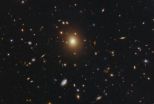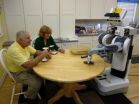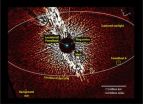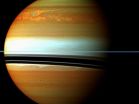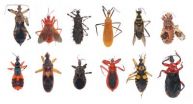(Press-News.org) Astronomers using the NASA/ESA Hubble Space Telescope have obtained a remarkable new view of a whopper of an elliptical galaxy, with a core bigger than any seen before. There are two intriguing explanations for the puffed up core, both related to the action of one or more black holes, and the researchers have not yet been able to determine which is correct.
Spanning a little over one million light-years, the galaxy is about ten times the diameter of the Milky Way galaxy. The bloated galaxy is a member of an unusual class of galaxies with an unusually diffuse core filled without any a concentrated peak of light around a central black hole. Viewing the core is like seeing a city with no centre, just houses sprinkled across a vast landscape.
An international team of astronomers used Hubble's Advanced Camera for Surveys and Wide Field Camera 3 to measure the amount of starlight across the galaxy, catalogued as 2MASX J17222717+3207571 but more commonly called A2261-BCG (short for Abell 2261 Brightest Cluster Galaxy). Located three billion light-years away, the galaxy is the most massive and brightest galaxy in the Abell 2261 cluster.
The Hubble observations revealed that the galaxy's puffy core, measuring about 10 000 light-years, is the largest yet seen. A galaxy's core size is typically correlated with the dimensions of its host galaxy, but in this case, the central region is much larger than astronomers would expect for the galaxy's size. The bloated core is more than three times larger than the centre of other very luminous galaxies.
Astronomers have proposed two possibilities for the puffy core. One scenario is that a pair of merging black holes gravitationally stirred up and scattered the stars. Another idea is that the merging black holes were ejected from the core. Left without an anchor, the stars began spreading out even more, creating the puffy appearance of the core.
Previous Hubble observations have revealed that supermassive black holes, with masses millions or billions times more than the Sun, reside at the centres of nearly all galaxies and may play a role in shaping those central regions.
"Expecting to find a black hole in every galaxy is sort of like expecting to find a pit inside a peach," explains astronomer Tod Lauer of the National Optical Astronomy Observatory in Tucson, USA, a co-author of the Hubble study. "With this Hubble observation, we cut into the biggest peach and we can't find the pit. We don't know for sure that the black hole is not there, but Hubble shows that there's no concentration of stars in the core."
Team leader Marc Postman of the Space Telescope Science Institute in Baltimore, USA, said the galaxy stood out in the Hubble image. "When I first saw the image of this galaxy, I knew right away that it was unusual," Postman explained. "The core was very diffuse and very large. The challenge was then to make sense of all the data, given what we knew from previous Hubble observations, and come up with a plausible explanation for the intriguing nature of this particular galaxy."
The paper describing the results appeared in the 10 September issue of the Astrophysical Journal.
The astronomers expected to see a slight cusp of light in the galaxy's centre, marking the location of the black hole and attendant stars. Instead, the starlight's intensity remained fairly even across the galaxy.
One possibility for the puffy core may be due to two central black holes orbiting each other. These black holes collectively could have been as massive as several billion suns. One of the black holes would be native to the galaxy, while the second could have been added from a smaller galaxy that was gobbled up by the massive elliptical.
In this scenario, stars circling in the giant galaxy's centre came close to the twin black holes. The stars were then given a gravitational boot out of the core. Each gravitational slingshot robbed the black holes of momentum, moving the pair ever closer together, until finally they merged, forming one supermassive black hole that still resides in the galaxy's centre.
Another related possibility is that the black hole merger created gravity waves, which are ripples in the fabric of space. According to the theory of general relativity, a pair of merging black holes produces ripples of gravity that radiate away. If the black holes are of unequal mass, then some of the energy may radiate more strongly in one direction, providing the equivalent of a rocket thrust. The imbalance of forces would have ejected the merged black hole from the centre at speeds of millions of kilometres per hour, resulting in the rarity of a galaxy without a central black hole. "The black hole is the anchor for the stars," Lauer explains. "If you take it out, all of a sudden you have a lot less mass. The stars aren't held together very well and they move outwards, enlarging the core even more."
The team admits that the ejected black-hole scenario may sound far-fetched, "but that's what makes observing the Universe so intriguing -- sometimes you find the unexpected," Postman says.
Lauer adds: "This is a system that's interesting enough that it pushes against a lot of questions. We have thought an awful lot about what black holes do. But we haven't been able to test our theories. This is an interesting place where a lot of the ideas we've had can come together and can be tested, fairly exotic ideas about how black holes may interact with each other dynamically and how they would affect the surrounding stellar population."
The team is now conducting follow-up observations with the Very Large Array radio telescope in New Mexico. The astronomers expect material falling onto a black hole to emit radio waves, among other types of radiation. They will compare the VLA data with the Hubble images to more precisely pin down the location of the black hole, if it indeed exists.
The Abell 2261 cluster is part of a multi-wavelength survey, led by Postman, called the Cluster Lensing And Supernova survey with Hubble (CLASH). The survey probes the distribution of dark matter in 25 massive galaxy clusters.
INFORMATION:
Links
[Research Paper][1]
[Images of Hubble][2]
[NASA release][3][][3]
Contacts
Marc Postman
Space Telescope Science Institute
Baltimore, USA
Tel: +1-410-338-4340
Email: postman@stsci.edu
Oli Usher
Hubble/ESA
Garching, Germany
Tel: +49-89-3200-6855
Email: ousher@eso.org
Tod Lauer
National Optical Astronomy Observatory
Tucson, USA
Tel: +1-520-318-8920
Email: lauer@noao.edu
Ray Villard
Space Telescope Science Institute
Baltimore, USA
Tel: +1-410-338-4514
Email: villard@stsci.edu
Monster galaxy may have been stirred up by black-hole mischief
2012-10-26
ELSE PRESS RELEASES FROM THIS DATE:
Exercise boosts satisfaction with life, researchers find
2012-10-26
UNIVERSITY PARK, Pa. -- Had a bad day? Extending your normal exercise routine by a few minutes may be the solution, according to Penn State researchers, who found that people's satisfaction with life was higher on days when they exercised more than usual.
"We found that people's satisfaction with life was directly impacted by their daily physical activity," said Jaclyn Maher, graduate student in kinesiology. "The findings reinforce the idea that physical activity is a health behavior with important consequences for daily well-being and should be considered when developing ...
Robots in the home: Will older adults roll out the welcome mat?
2012-10-26
Robots have the potential to help older adults with daily activities that can become more challenging with age. But are people willing to use and accept the new technology? A study by the Georgia Institute of Technology indicates the answer is yes, unless the tasks involve personal care or social activities.
After showing adults (ages 65 to 93 years) a video of a robot's capabilities, researchers interviewed them about their willingness for assistance with 48 common household tasks. Participants generally preferred robotic help over human help for chores such as cleaning ...
New genes discovered for adult BMI levels
2012-10-26
A large international study has identified three new gene variants associated with body mass index (BMI) levels in adults. The scientific consortium, numbering approximately 200 researchers, performed a meta-analysis of 46 studies, covering gene data from nearly 109,000 adults, spanning four ethnic groups.
In discovering intriguing links to lipid-related diseases, type 2 diabetes and other disorders, the IBC 50K SNP Array BMI Consortium's study may provide fundamental insights into the biology of adult obesity. Scientists from the Center for Applied Genomics at The Children's ...
Academia should fulfill social contract by supporting bioscience startups, case study says
2012-10-26
Universities not only provide the ideal petri dish for cultivating bioscience with commercial potential, but have a moral obligation to do so, given the opportunity to translate public funding into health and jobs, according to a new case study by UCSF researchers.
In an analysis published Oct. 24, 2012 in Science Translational Medicine, researchers at the California Institute for Quantitative Biosciences (QB3) assessed the impact of the institute's efforts over the past eight years in supporting entrepreneurs on the three UC campuses in which it operates: UCSF, UC Berkeley ...
Scientists deepen genetic understanding of MS
2012-10-26
Five scientists, including two from Simon Fraser University, have discovered that 30 per cent of our likelihood of developing Multiple Sclerosis (MS) can be explained by 475,806 genetic variants in our genome. Genome-wide Association Studies (GWAS) commonly screen these variants, looking for genetic links to diseases.
Corey Watson, a recent SFU doctoral graduate in biology, his thesis supervisor SFU biologist Felix Breden and three scientists in the United Kingdom have just had their findings published online in Scientific Reports. It's a sub-publication of the journal ...
Sharing space:
2012-10-26
A new University of Michigan study shows that when researchers share a building, and especially a floor, the likelihood of forming new collaborations and obtaining funding increases dramatically.
The findings have wide relevance to corporations, as well.
"Our analyses clearly show that there are benefits to co-location," said Jason Owen-Smith, an associate professor of sociology and organizational studies.
Researchers who occupy the same building are 33 percent more likely to form new collaborations than researchers who occupy different buildings, and scientists who ...
New study brings a doubted exoplanet 'back from the dead'
2012-10-26
A second look at data from NASA's Hubble Space Telescope is reanimating the claim that the nearby star Fomalhaut hosts a massive exoplanet. The study suggests that the planet, named Fomalhaut b, is a rare and possibly unique object that is completely shrouded by dust.
"Although our results seriously challenge the original discovery paper, they do so in a way that actually makes the object's interpretation much cleaner and leaves intact the core conclusion, that Fomalhaut b is indeed a massive planet," said Thayne Currie, an astronomer formerly at NASA's Goddard Space ...
NASA spacecraft sees huge burp at Saturn after large storm
2012-10-26
NASA's Cassini spacecraft has tracked the aftermath of a rare massive storm on Saturn. Data reveal record-setting disturbances in the planet's upper atmosphere long after the visible signs of the storm abated, in addition to an indication the storm was more forceful than scientists previously thought.
Data from Cassini's composite infrared spectrometer (CIRS) instrument revealed the storm's powerful discharge sent the temperature in Saturn's stratosphere soaring 150 degrees Fahrenheit (83 kelvins) above normal. At the same time, researchers at NASA's Goddard Space Flight ...
A clearer picture of how assassin bugs evolved
2012-10-26
RIVERSIDE, Calif. — Assassin bugs, so named because these insects lie in ambush for prey that they attack with speed and precision, are found all over the world. Nearly 140 species of these bugs are blood-sucking; because they can bite humans around the mouth, they are also called kissing bugs. All kissing bugs can spread Chagas disease, a neglected tropical disease that imposes an economic burden on society.
Surprising, then, that scientists' understanding of the evolutionary history of assassin bugs is riddled with difficulty. The data are incomplete. Fossils, which ...
High-risk carotid artery plaque formation is increased in older COPD patients
2012-10-26
Older patients with chronic obstructive pulmonary disease (COPD) are at increased risk for carotid artery plaque formation and for the presence of vulnerable plaques with a lipid core, according to a new study from researchers in the Netherlands.
"We know that COPD is a risk factor for ischemic stroke, and that certain components of carotid artery plaques such as intraplaque hemorrhage and lipid core increase the risk of ischemic events, but plaque composition in patients with COPD has not been examined," said researcher Bruno H.C. Stricker, MD, PhD, professor of pharmaco-epidemiology ...
